Published
on 15
May 2008
|
All rights reserved.
|
|
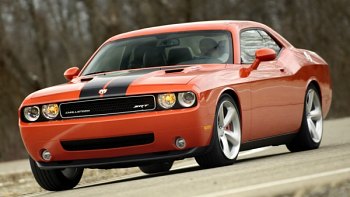
|
The 2008 Challenger looks every bit a
remake of the original...
|
Muscle
cars seem a thing of
the past, yet in recent years Detroit’s car makers tried very hard to
bring back the muscle car era. The reason behind is simple – they are
not capable to defeat the imports square and fair, so they need the
help of American heritage to boost sales. As a result, you can see the
return of Ford Mustang GT500, Chevrolet Camaro and this one,
Dodge Challenger. All these cars resemble the muscle cars bearing the
same names from mid-1960s to early 1970s, no matter in looks, power and
feel. This sounds quite ridiculous to the market trend of reducing fuel
consumption and emission. They are not my cup of tea, but unfortunately
there are many car enthusiasts out there love them.
Dodge division of Chrysler group produced the original Challenger from
1970-74, during which around 180,000 units were sold. By numbers it was
not exactly a huge success, but its design and image provide a useful
basis for the second incarnation. The 2008 Challenger looks every bit a
remake of the original, with the same coke bottle waistline and 1970s
front and rear design. Forward thinkers will criticize it for too retro
- retro to the extent that sacrifices modern requirements for
aerodynamics and visibility, but its wildness does inspire strong
emotion. Love it or hate it,
you can’t deny that it is design-led car.
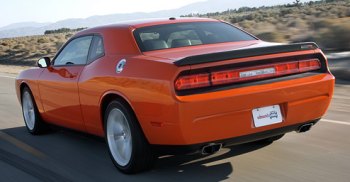
|
Based on a shortened LX platform, it
is still a big monster...
|
The original Challenger was built on a
shortened Barracuda
platform. Similarly, the new Challenger is built on a shortened version
of Chrysler 300 / Dodge Charger’s LX platform. Some 100 mm of wheelbase
has been chopped together with the rear doors to make it a 2+2 coupe,
albeit a roomy 2+2. No one would describe the Challenger as compact, as
its “short” wheelbase still measures a limousine-like 2946 mm, its
length still exceeds 5 meters and it weighs close to 1.9 tons. In fact,
it is as large and heavy as a Mercedes CL500 !
Fortunately, in the first production year Chrysler will produce only
the highest performance model, SRT8. The 6.1-liter HEMI push-rod V8
with 425 horsepower and 420 lb-ft of torque deals with the weight with
ease. Even though mated with the slightly outdated Mercedes 5-speed
automatic (whose downshift is slow), it can still crack 0-60 mph in
less than 5 seconds and 0-100 mph in 11 point something seconds. Top
speed is around 168 mph. Apart from real muscle car performance, the
HEMI engine also produces a fantastic noise when the throttle is wide
open. Cruising on highway, it is reasonably quiet. The only downside is
fuel consumption – 13 mpg in city and 18 mpg on highway, very much like
a muscle car.
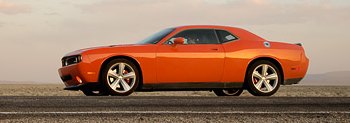
|
Don't assume the Challenger SRT8 a
challenger to BMW M3...
|
In contrast, the chassis and
suspensions come from a modern
era. You may still remember many suspensions and drivetrain components
of Chrysler 300C were sourced or adapted from Mercedes E-class. The
same goes for its short-wheelbase brother. Moreover, with a slightly
stiffer 2-door chassis and slightly stiffer suspension setting (by
around 7 percent), the Challenger SRT8 handles even better than 300C
SRT8. It contains roll and pitch better while delivers a reasonably
comfortable ride. Its wide tires provide bags of grip. It has
world-class stoppers, too – those big Brembo brakes with 4-pot aluminum
calipers are powerful and fade-free.
However, don’t assume the Challenger SRT8 a challenger to BMW M3. Once
you push it closer to the limit, you will notice its sheer size and
weight
through its excessive body movement and its reluctance to steer (i.e.
understeer). You may complain its steering for being too slow, too numb
and the steering wheel too big – like a good old muscle car again.
These dynamic deficiencies prevent it from matching European coupes.
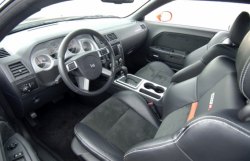 |
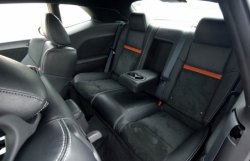 |
The cabin is another downside of the car. Despite of an ultra-long
wheelbase, the rear seats (strictly for two) are not especially
spacious. Seats are undeniably supportive, but they look ugly and
cheap. The same goes for the dashboard, which has none of the style and
quality feel of European cars. How can it compete with a
similarly-priced BMW 335i Coupe ?
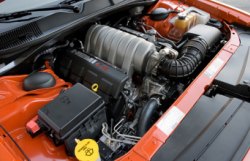
|
The HEMI engine produces a fantastic
noise when the throttle is wide open... |
If you want the muscle car looks of
Challenger without
spending the north of US$40,000 on SRT8, you may wait for next year’s
full range to come. That will include a base SE model powered by the
old 250hp 3.5 V6 and a R/T model with 5.7-liter HEMI V8. The latter is
updated with variable valve timing and boosted output to 370hp. That
could be more sensible than entering the league of BMW.
However, it is questionable to me how many car lovers out there can
sustain the sales of a retro-style muscle car. The market has Ford
Mustang already and is going to be joined with Chevrolet Camaro. Once
the initial interest dried out, people will look forward to better
quality and higher efficiency. The smaller and lighter Mustang and
Camaro will have an edge over Challenger. European and Japanese coupes
will have an edge over them again. In my opinion, going retro and
muscle is not too sensible these days.
|
Verdict:   |
Published
on 1
Oct 2008
|
All rights reserved.
|
|
Challenger R/T and SE
|
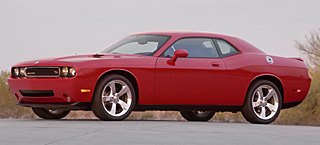
|
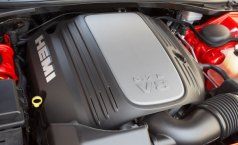
|
| R/T is a sensible alternative to
SRT8 |
|
Chrysler
launched the new Challenger from top down. First came the flagship SRT8
in 2008 model year, then come the mass market 3.5 SE and 5.7 R/T in
2009 model year. They are expected to take the bulk of the sales.
The 3.5 SE is powered by the company's outdated 3.5-liter SOHC 24-valve
V6 like the base Chrysler 300 and Dodge Charger. Without any
modifications, its output remains 250 hp and 250 lb-ft. That would not
have been much problematic to a regular size car, but the Challenger is
a dinosaur, weighing close to 1700 kg even in the V6 form. Worse still,
the only transmission available is a 4-speed automatic, an old partner
to this engine. The combo has been serving Chrysler group since the
LH-platform Chrysler 300C, which means more than 10 years old.
The good thing is they are well proven. The bad thing is they are
proved to be slow and unrefined. The rest of the package is
equally outdated. You get a cheap cabin trim and small rear passenger
space to match its low price. It feels monsterious huge on back roads
and breathless on highway. The only thing it delivers is a muscle car
look. Everything else doesn't worth praising. The SE is definitely not
to be recommended.
The 5.7 R/T is better, at least it has true muscle car performance.
Chrysler has improved its 5.7-liter HEMI V8 recently. Despite of the
push-rod 2-valve-per-cylinder architecture, it is actually quite
sophisticated. To save fuel when high power is not required, it can
deactivate the valves in 2 of the cylinders each bank, so the V8
effective becomes a V4.
A new feature this year is variable cam phasing which acts on the
only camshaft in the block. In addition to other modifications, the 5.7
V8 has its
output increased to 372 hp and 401 lb-ft, not much behind SRT8. As the
R/T is priced at US$30,000 (versus the SRT8's US$40,000), many people
see it as a sensible alternative to SRT8. However, those choosing the
R/T should be aware of its slightly softer suspensions, cheaper brakes,
modest 18-inch wheels and 235/55VR18 tires, cheaper seats and fewer
standard equipments. On the road, these translate to an even more
ponderous handling. In fact, many hot hatches are actually more fun to
drive in mountain roads. From this view, the US$30,000 and very high
fuel costs it asks for is hardly reasonable. |
Verdict:   |
Published
on 10
Jan 2011
|
All rights reserved.
|
|
Challenger SRT8 392 and SE 3.6
|
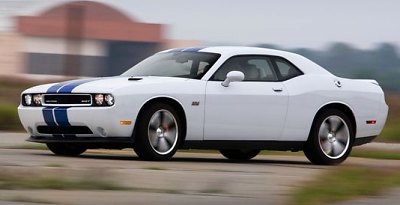
|
Ever rising power figures cannot
change our verdicts
|
After a 2-year pause, all Chrysler
group products get some
kind of refresh in year 2011. As Dodge Challenger is the youngest among
them, it gets the lightest modifications. Apart from a fancy paint
scheme, it is cosmetically unchanged from the new car, so the term
"facelift" does not apply to it. Instead of looks, the changes lie
under the bonnet. Headline is the SRT8 392 – yes, the number refers to
its larger, 392 cubic inch displacement. In metric unit it translates
to 6410cc, up from 6059cc.
Apart from increased capacity, the 392 HEMI V8 has a few significant
improvements over the old engine. The first is cylinder deactivation,
which shut down 4 of the 8 cylinders under part load to save fuel.
However, it is only available to the engine mated with automatic box.
The second is a two-stage variable intake manifolds. It enhances
mid-range torque, generating an extra 90 lb-ft at 2900 rpm, for
example. Another improvement is the addition of variable cam phasing to
its sole camshaft. It is not the sophisticated "cam-in-cam" design of
the late Viper, so the exhaust valve timing is always compromised when
intake valve timing is advanced. Still, it enhances high-rpm breathing
a little bit. Overall, the 392 HEMI produces 470 hp and 470 lb-ft of
torque, 45hp and 50 lb-ft up respectively.
We don't doubt its firepower – as in the old car – but the way it put
the power in use is questionable. Lacking a sophisticated launch
control or twin-clutch transmission, the American muscle car struggles
to translate those extra horsepower and torque to performance. Time is
wasted to tire slip and gearchange, so 0-60 mph sees only marginal
improvement to 4.5 seconds. 0-100 mph sprint in just over 10 seconds is
no longer enough these days, especially for a car single-minded on
straight-line performance.
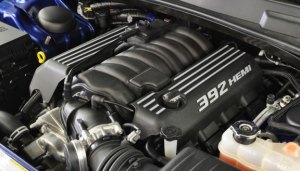
|
Lacking a launch control or
twin-clutch box, it struggles to translate those extra power to
performance...
|
Moreover, performance alone can hardly
satisfy these days. Chrysler also knows this, so it retuned the
Challenger's suspensions and steering for the better of handling. A
faster steering ratio, more negative camber, stiffer suspension
bushings and dampers make the car less bulky in the twisty. It is more
willing to turn into corners, and rolls less in the process.
Nevertheless, burdened by a ridiculous 1900 kg – and 55 percent of them
acted on the front axle – it can hardly feel agile. You still need to
keep discipline on brake and throttle approaching and exciting bends.
Its power still overwhelms its chassis. This is still very much a
muscle car.
Take into account the disgusting retro design and rubbish-level
interior, the Challenger SRT8 392 is not going to change our verdict.
Lower down the range, the base Challenger SE gets Chrysler's new
Pentastar V6. In this application, the 3.6-liter DOHC DVVT unit is
tuned to produce 305 horsepower, far more than the old unit's 250hp.
Nevertheless, its mandatory 5-speed automatic box is not going to do it
any favour against Ford and Chevy's 6-speeder. The result is still the
slowest V6 pony car. |
Verdict:   |
| Published
on 26
Jul 2014 |
All rights reserved.
|
|
Challenger SRT Hellcat
|
|
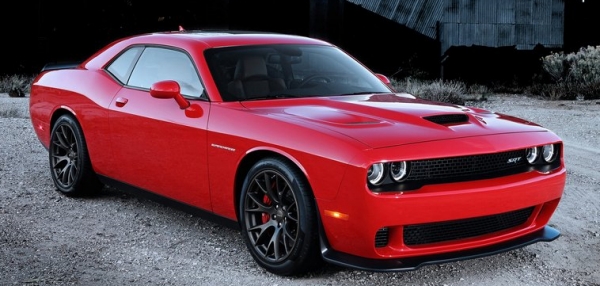 |
|
More
powerful than a Viper, Hellcat aims at beating Mustang GT500 and Camaro
ZL1 as the America's top muscle car.
|
|
Dodge Challenger,
one of the three American pony cars remaining on sale, has received an
update. All models get a subtle facelift, upgraded equipment and
interior trims and a much better ZF 8-speed automatic gearbox (in place
of the long-serving DaimlerChrysler 5-speeder). The 3.6-liter V6 and
5.7-liter Hemi V8 remain unchanged, while the SRT8's 6.4-liter Hemi is
added with another 15 hp. However, headline news must be the new
range-topping model, Hellcat. Named after a famous WWII fighter plane
of the US Navy, it aims at beating Ford Mustang GT500 and Chevrolet
Camaro ZL1 as the America's top muscle car. How can it do that? The
answer is a new 6.2-liter supercharged V8 that pumps out an astonishing
707 horsepower and 650 pound-foot of torque. Yes, that's more than the
662 hp on Mustang and 580 hp on Camaro. It is also more powerful than
the new Corvette Z06 (650 hp) and Chrysler's own top performance car,
Viper (640 hp)! This is currently the most powerful American production
car.
 |
|
Supercharged
V8 produces 707 horsepower
|
|
The Hellcat engine is derived from the 6.4-liter Hemi, but with reduced
stroke its displacement is down slightly to 6184 c.c. There is nothing
state-of-the-art in its design, but it adopts the necessary measures to
boost output and withstand higher stresses. The engine block is still
that durable cast-iron item (which explains why the whole engine is 82
kg heavier than the Viper's V10). The aluminum cylinder heads are
heat-treated to increase strength. Forged aluminum pistons, forged
steel connecting rods and crankshaft are employed. The piston pins have
diamond-like carbon coating to reduce friction. Sitting inside the V is
a Japanese IHI Lysholm supercharger – surprisingly, not the American
Eaton, though IHI had a good history of supplying AMG's supercharged V6
and V8 in the past. It displaces 2380 c.c. and spins up to 14,600 rpm,
so by calculation you will find it supplies essentially the same amount
of air per minute as the Corvette Z06 (1740 c.c. x 20,000 rpm). It
produces a maximum boost pressure of 0.8 bar. What the Hellcat engine
cannot match the latest Chevy is efficiency, because it lacks modern
features like direct fuel injection and cylinder deactivation. Its
immense weight, tallness and wet sump explain why it is used on a
muscle car instead of a true sports car.
On the road, the Hellcat engine dominates the driving experience. It
launches like an old-school muscle car, with lots of spin and smoke
which is not an effective way to register good acceleration figures.
Even though the car has an electronic launch control, it struggles to
find enough traction at the rear axle (due to front-biased weight
distribution) to contain the tremendous power. Expect 0-60 mph to be
worse than Mustang GT500 at about 4 seconds, and 0-100 mph should take
around 8 and a half second. Once on rolling, the sense of power is very
strong. It sings in thunder and pushes with endless energy, passing 150
mph effortlessly – perhaps the quoted 199 mph top speed is true.
Surprisingly, the ZF auto – beefed up for this application – works very
well, shifting gears responsively and choosing gears smartly even when
you push it on a track, so good that you can forget the Viper-sourced
Tremec 6-speed manual.
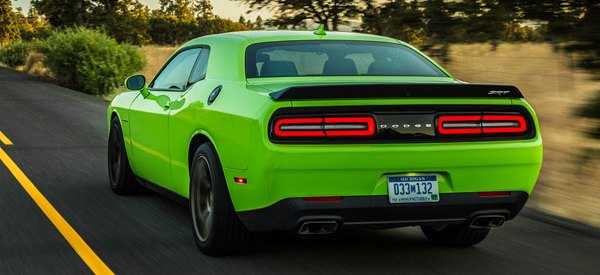 |
|
On
the road, the Hellcat engine dominates the driving experience...
|
|
The regular SRT8 has always been criticized for poor handling. Despite
of an even heavier engine, the Hellcat maneuvers with less pitch and
roll, thanks to thicker anti-roll bars, stiffer springs and dampers.
The fatter Pirelli 275/40ZR20s and larger Brembo brakes (with 390 mm
discs clamped by 6-pot calipers up front, 350 mm discs and 4-pot at the
back) also improve its handling considerably. That said, no one will
confuse it with a BMW M4 in the twisty. It is still a large 2-ton
machine with poor static balance. You need patience to get around
corners. Should you brake too late or too abruptly, you will end up
sideway. Should you apply too much throttle at corner exit, you will
get big oversteer and probably miss the next corner. The key technique
to tame it is "slow in, slow out", i.e., very much like driving a
conventional muscle car.
It must be said that despite of its temper, the Hellcat is not as
difficult to drive as Mustang GT500, which is even more prone to
throttle-induced oversteer. However, it is certainly not as nimble as
Camaro ZL1, let alone the world-class Camaro Z/28 and Mustang Boss 302.
What the Hellcat beats them are the usual merits of Challenger, i.e. a
roomy cabin, comfortable seats and modern equipment. Its ride quality
is pretty smooth for its performance class, too. To live with on a
daily basis, the Hellcat is sweeter than its name suggested.
|
Verdict:    |
| Published
on 25
Jul 2017 |
All rights reserved.
|
|
Challenger SRT Demon
|
|
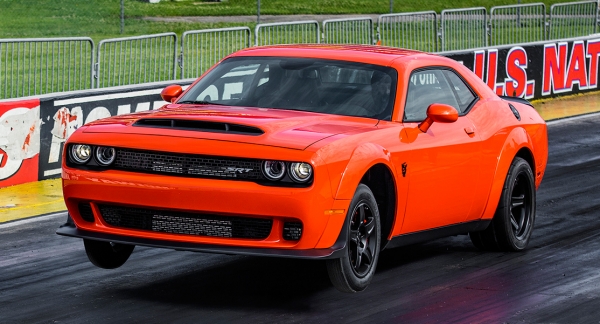
|
|
Demon
is an answer to a question nobody asked: build the ultimate road-legal
dragster!
|
|
I doubt if I have ever
seen any production cars as single-minded as this one. The new Dodge
Challenger SRT Demon is NOT the GT3 RS version of Hellcat, which would
have been far more versatile. In fact, it is designed purely for drag
race. All mechanical changes are made to improve 1/4-mile standing
start as far as possible, even at the expense of handling or overall
performance in the real world.
Power comes from the 6.2-liter supercharged HEMI V8 like the Hellcat,
but FCA gave it a larger (2.7 liters instead of 2.4 liters)
supercharger which offers a higher (1.0 bar instead of 0.8 bar) boost
pressure. A larger airbox is fed by the prominent scoop on the hood.
The V8 is allowed to rev to 6500 rpm, 300 rpm higher than before. Its
fuel pump is upgraded to supply more fuel. Its pistons and con-rods are
stronger, too. Drinking regular fuel, it is already good for 808 hp and
717 lbft of torque, compared with 707 hp and 650 lbft of the Hellcat.
When it is fed with 100 Octane race fuel, the output is lifted to 840
hp and 770 lbft. Both easily crown it the most powerful production car
in the world. By the way, "production car" here means a production run
of 3300 units, 3000 to the US and 300 to Canada.
To aid drag race, Demon goes as far as using the air conditioning's
refrigerant to help cooling the charge cooler of the supercharger. This
allows the car to recover faster after each drag run.
To cope with the extra torque, the automatic transmission's torque
converter is upgraded. It is added with launch control and a “trans
brake” feature specially designed for dragsters. Launch control makes
quick launch easily repeatable, but the Demon’s 1/4-mile record of 9.65
seconds (at 140mph) was achieved in trans brake mode instead, which
locks the output shaft while revving the engine to produce maximum
torque just before launch.
Traction is another key issue for faster acceleration. The Demon uses
Nitto NT05R drag race tires (but street legal). At 315/40R18, they are
2-inch smaller than the Hellcat's but 40mm wider. The contact patch
area is increased by 15 percent, while total traction is doubled. The
smaller alloy wheels are lighter, but they cannot fit the Hellcat's
390mm front brake discs, so the latter are downgraded to 360mm items.
Never mind, this car is all about acceleration, so who cares
deceleration?
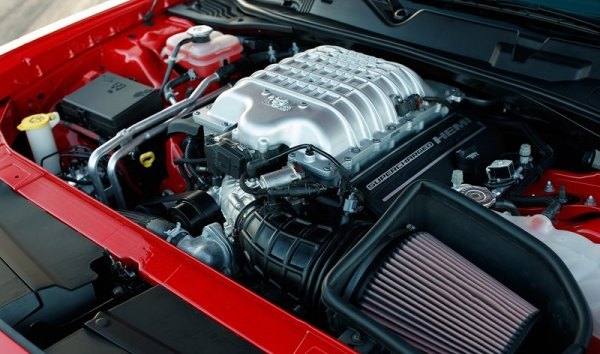
|
|
With
808hp on tap (or 840hp drinking race fuel), this is the world's most
powerful production engine.
|
|
Drag race performance also dictates the suspension setup. To enhance
traction, the springs are actually softened (by 35% front and 28%
rear), ditto the anti-roll bars (-75% / -44%) and adaptive damper
setting (which switches to even softer setting in drag mode), so that
more weight transfer to the rear wheels during acceleration. In
addition to reduced negative camber at the rear wheels, the rear tires
can remain in contact with the tarmac under harder acceleration.
Handling in corners? A nightmare, of course! R&T reported a lot of
roll and float on the road (note: other publications were not allowed
to test outside the dragstrip, unfortunately). This is caused by not
only the soft suspension but also the high and soft sidewalls of the
tires. Switch the adaptive dampers to Sport mode restores some control,
but it is still not the handling you would expect for a
high-performance car. Besides, steering feel through the wide front
tires is always muted.
If you are hardcore, you can opt for weight-saving measures which cut
around 80 kg from the Hellcat's 2018 kg kerb weight. These go as far as
ditching not only the audio, sound deadening materials and the rear
seats but also the front passenger seat! The result is a spartan, noisy
and lonely cabin.
Who would buy this car then? Amateur drag racers, of course. It is
nearly impossible to replicate FCA’s claim of 0-60 mph in 2.3 seconds
or the 9.65 seconds quarter mile, unless you are helped by perfect
weather, a strong tail wind and luck, but drag racers will find immense
satisfaction for trying to do so, using the throttle and both shift
paddles to manage the launch. A successful launch could yield 1.8g of
acceleration or even lift up the front wheels as pictured.
Unfortunately, dragstrip is the only place its performance designed to
shine. For 99 percent of us, the talent of Demon is too limited, and it
sacrifices almost everything else for that purpose. No, that's not the
car for our taste.
While $86,000 sounds a bargain for the performance it offers, bear in
mind that the best R&T managed in a whole day was 0-60 mph in 2.6
seconds and 0-100 mph in 6.1 seconds, slower than a Tesla Model S
P100D. A Camaro ZL1 1LE or Mustang GT350R are not as quick in straight,
but should be easily quicker in a course or most roads, not to mention
their much more versatile manner. The Demon made headlines, but it is
an answer for a question nobody asked, not even the hardcore drivers.
|
Verdict:  |
| Published
on 17
Aug 2018 |
All rights reserved.
|
|
Challenger SRT Hellcat Redeye and R/T Scat
Pack 392
|
|
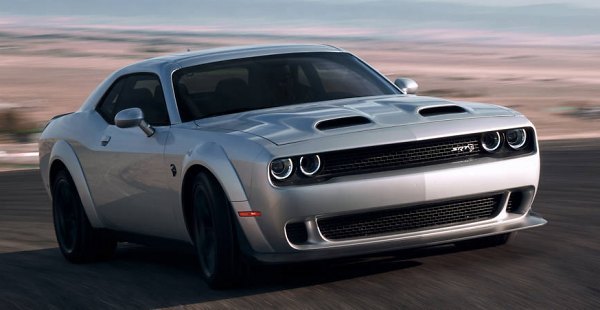
|
|
Redeye
has tons of power, but it is the R/T Scat Pack that delights the
driver, relatively.
|
|
It is easy to get lost in
the countless variants, options and packages of Dodge Challenger, let
alone the changes between model years. This is the trick American
manufacturers used to sell you pony cars. When you are busying figuring
out which combination is the smartest buy, you forget about the essence
of the car. Let me remind you: the Challenger is a dinosaur. It is
built on the old LX platform debuted 14 years ago, and its suspensions
were adapted from the 2002 Mercedes W211, the grandfather of today’s
E-class. Modern coupes talk about precision, agility, response and
efficiency. In contrast, the Challenger has one and only one selling
point: power. To keep orders flowing in, it has to offer
headline-grabbing power output. And offer more each year. So far, this
strategy has been proved quite successful, as its sales is actually
increasing. Last year, it shifted 65,000 Challengers in the USA,
trailing Camaro (68,000 cars) by a whisker, although Mustang remains
untouchable at 82,000 cars. For a 10-old-year model, this is amazing.
In the power chart of Challenger, the base is still the 3.6-liter V6
with 305hp. You can have it for as little as $27K. Then, the 5.7-liter
Hemi V8 with 372hp (from $34K), the 6.4-liter (392cu) V8 with 485hp
(from $40K), the 6.2-liter supercharged V8 with 717hp (Hellcat, from
$60K) or 840hp (Demon, from $86K but sold out). The more cash brings
more power. But more fun? Not necessarily.
Take the latest R/T Scat Pack 392 for example, it employs the naturally
aspirated 6.4 engine and 6-speed manual gearbox. It trails the
supercharged models by at least 230 horsepower, but it is actually the
sweetest driving Challenger of all. With nearly 100 kilograms of less
weight acted over its front axle, it feels keener to turn, and its
power is well matched with the chassis, rarely spinning the rear wheels
or running into oversteer as easily as the Hellcat. Moreover, you can
now opt for “Widebody” package to enhance its handling further. Its
extended wheel arches accommodate wider and stickier 305/35ZR20 P-Zero
rubbers. Its front springs have been stiffened by 14 percent. Its
anti-roll bars thickened. Its large disc brakes, with 6-pot Brembo
calipers up front, are shared with the Hellcat, as are the 3-mode
adaptive dampers. FCA said this is the Challenger designed for tracks.
It might be an overstatement beside a Mustang GT350R or Camaro SS 1LE,
but it is undoubtedly the closest thing to that statement among its
siblings.
A stark contrast is the new SRT Hellcat Redeye. This is the muscle car
of muscle car. Practically a street version of Demon, it has the Demon
engine transplanted under its bonnet. This means, the 6.2-liter Hemi
has a larger, 2.7-liter supercharger pumping 1.0 bar of boost,
supported with stronger pistons, con-rods and cooling system. It is
also given the Demon’s heavy-duty version of ZF 8-speed automatic
transmission to handle its mega torque output. 797hp and 707lbft are
slightly less than those of Demon, as it loses the latter’s large
bonnet scoop (which would have generated too much aerodynamic lift at
high speed) and the capability to drink race fuel. Still, this has to
be the world’s cheapest 800hp car, as well as the cheapest 200mph
runner. Its top speed is 203mph. 0-60 mph is claimed to take 3.4
seconds.
The chassis of Redeye is again available with that Widebody option,
which is strongly recommended to tame its wild power. It shares the
suspension and brakes upgrade with the widebody Scat Pack, but the
extra heft and 57:43 weight distribution means it struggles to match
its lighter sibling on a track. Throttle has to be applied with
discipline, otherwise you will risk spinning the rear axle. Corners
have
to be taken with patience. Brake early, wait until it exits the bend
and get back to throttle slowly, because it has way more grunt than its
rear axle can take. It does feel more secured and planted than the old,
narrow body Hellcat, but everything is relative.
On road, the Redeye is even more difficult to use its excess power. You
will find its supercharged engine less delicious to
ears than the naturally aspirated Hemi, and its heavy duty transmission
shifts less smoothly. Ride comfort and high speed stability, however,
are surprisingly good. Coupling to the spacious cabin, it can be seen
as a nice GT. Just don’t compare its looks with an Aston Martin.
The Redeye is not as expensive as Aston Martin, of course, but after
ticking the essential options, it ends up at $90K. At that price, you
have plenty of other options from European prestige marques, including
Porsche 718, Audi TT RS, BMW M4, or what about Alfa Giulia QF? The R/T
Scat Pack widebody is different. You can have it reasonably well
equipped for $50K, though you lose the headline-grabbing output and top
speed. That said, neither cars drive as well as the equivalent Camaro
and Mustang, blame to their bulk and that aging chassis.
|
Verdict:
SRT Hellcat Redeye:  
R/T Scat Pack:    |
|